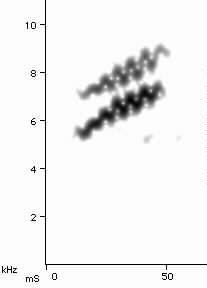
Mourning Warbler Oporornis philadelphia
Flight call description An abrupt, rising "vzit".
Fig.1. Presumed Mourning Warbler flight call. Maryland August 30, 1994 (MO).
Unidentified yellow-bellied warbler seen in short diurnal flight (see Discussion).
Examples Nocturnal
Similar species Similar to "double-banded up-seep" group, especially Nashville Warbler, but lower and buzzier. See short rising seeps.
Behavior Primarily a nocturnal migrant. Gives flight call rarely while perched and in short flights during the day, but this call type is documented regularly during nocturnal migration.
Spectrographic description Measured call (N=1) from presumed Mourning Warbler in fig.1 was 40.3 mS in duration and in the 5.5-9.0 kHz frequency range. The frequency track was double-banded and abruptly rising with distinct, jagged modulations. Modulations showed an average spacing of 5.6 mS between humps and a depth of 600 Hz. Presumed nocturnal flight calls measured (N=5) were 41.1-54.3 (49.9) mS in duration and in the 5.1-8.6 (5.3-8.1) frequency range. Calls were modulated with a spacing of 6.2-8.0 (7.0) mS between humps and a depth of 180-300 Hz.
Discussion This call is unconfirmed but was tentatively identified by process of elimination. We have heard this call type from Mourning Warblers during the day, but our only diurnal recording is of an unidentified yellow-bellied bird in a short diurnal flight. The latter call matches nocturnal flight calls of migrants recorded over New York in late August and Texas in May. This temporal pattern fits the expected migration time of Mourning Warbler. The unidentified call is otherwise most similar to Nashville Warbler but appears to be too low and too strongly modulated.